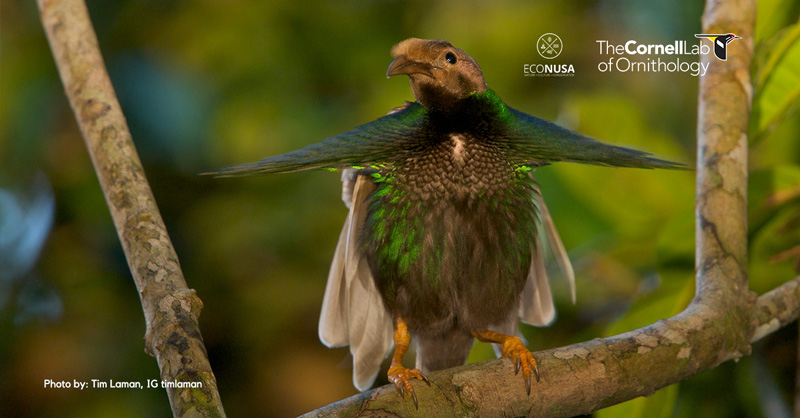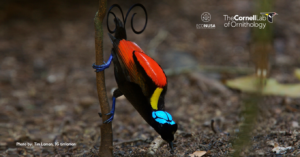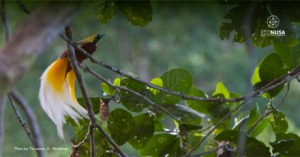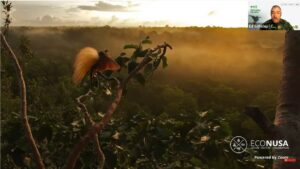
None doubts the beauty and appeal of bird-of-paradise. The colorful feather, its enchanting dance and beautiful chirp amidst the serenity of primary forests in Tanah Papua and Maluku Islands have mesmerized anyone. Their existence inspires many people. Moreover, many takes advantage of its existence.
From Asia mainland, the appeal of bird-of-paradise reaches European mainland. The spread happened following the return of Ferdinand Magellan expedition ship in 1522. In addition to clove, back to Spain, the Victoria ship crews also brought the skin of small bird-of-paradise or Lesser bird-of-paradise (Paradisea minor) with them. The bird served as a gift from Bacan Sultanate to Magellan which was then offered to the king of Spain.
Take part on: Support Defending Paradise Campaign to Protect Rainforest in Tanah Papua and Maluku Islands as birds-of-paradise habitat
Bird of God
In Magellan’s assistant journal, Antonio Pigafetta, described the beauty of bird-of-paradise as a bird with tail as dove’s; all of the feathers, but wing, are brownish yellow; and it has never flown but only when the wind was blowing. “We are informed that those birds came from earthly heaven and is called Bolon diuta (bird of god), that means the bird of God,” said Antonio.
bird-of-paradise had various names by end of 16th century. Portuguese called it bird of sun or passaros de sol and in Latin it is dubbed Avis paradiseus or bird of paradise. Malay traders called it dead bird as they had never seen bird-of-paradise alive.
Read also: Love May Warm Up, But Not Earth
The spreading myth in the society tells that bird-of-paradise has never perched on a tree and thus the bird keeps flying amidst the earth and sky till they are dead. Such an imagination has been kept in mind for hundreds of years. Upon publishing scientific publication of the Greater bird-of-paradise bird-of-paradise in 1758, Carolus Linnaeus, a taxonomist, proposed the scientific name of the bird as Paradisea apoda which means paradise without leg.
Only few Europeans at the time were lucky enough to perceive bird-of-paradise directly in their habitat. Among the few, Alfred Russel Wallace was more fortunate as he could keep the name.
Jointly with Ali, a Malay youngster whom he trusted, Wallace paid a visit Bacan Island (currently belongs to North Halmahera District, North Maluku Province) to collect specimens in October 1858. Ali brought some ‘weird’ birds with green feather on the chest and white along shoulders for Wallace. At first glance, Wallace felt he got a special gift for his collection.
Read also: Jurisdictional Approach in Sustainable Forest Natural Resources Management
“… I believe that I have possessed the best and most beautiful bird in that island. I would make it secret, but I could not help telling you that I got the new bird-of-paradise! … I think it was the biggest discovery I ever made …,” said Wallace.
That bird-of-paradise was dubbed the Nymph of Halmahera or Standardwing bird-of-paradise. Wallace registered the name with scientific name, Semioptera wallacii.

Besides, Wallace also found other bird-of-paradise when he was in Waigeo Island, Raja Ampat, in West Papua Province, in 1860. In his book, The Malay Archipelago, Wallace told his encounter with bird-of-paradise and his gratitude for finding the beauty of other bird-of-paradise. “But there is none going beyond the beauty of bird-of-paradise. I am the only English who had perceived the beauty of this bird in its origin forests,” he said.
Read also: Nature Destruction Triggers Ecological Disaster
bird-of-paradise has been used as souvenir. Moreover, the feather has become a distinguished commodity. It reached the peak in early 20th century when European and American were enamored by fashion of hat with bright colored feather. It evidently showed that in 1905-1920, around 30,000-80,000 bird-of-paradise birds were killed and their feathers went to auction house in London, Paris and Amsterdam.
On the later development, hat with bird-of-paradise feather was strongly rejected in Holland. Campaign for bird-of-paradise protection seemingly inspired Kooders, a scientist and forestry official in Dutch, who was unhappy with the Dutch environmental policy. Kooders chaired the Dutch natural Protection Association (NIVN) founded in 1912. Thanks to NIVN call, the first nature conservation was founded on 6-hectare plots of land in Depok. Then the ban for bird-of-paradise and crest dove hunting was issued in 1922.
Exploring Land of Paradise
The story of Wallace upon seeing the large yellow bird-of-paradise gave the adventurous spirit of the Blair and brother, Lawrence and Lorne Blair. They proposed a documentation of bird-of-paradise to Ringo Starr, the former personnel of The Beatles. Ringo approved their ideas and donated 2,000 pound sterling for financing their travel and post-production.
The Blair and brother arrived in Indonesia in 1972. They spent 10 years to document the various ‘miracles’ of Indonesia. Their expedition was released in two media, a film serial, Ring of Fire: An Indonesian Odyssey, and book on Ring of Fire: Indonesia dalam Lingkaran Api. Their film was bought by the Public Broadcasting Service (PBS) in the US in cooperation with BBC. Their toils paid by an Emmy Award in 1988.
Read also: Evaluating Palm Oil License in West Papua
Unfortunately, there is no complete documentation of the Paradisaeidae family in Maluku Island, Tanah Papua, Papua New Guinea and Australia. Edwin Scholes, an ornithologist of Cornell University, and Tim Laman, a photographer and biologist, were obsessed by filling the information gap on bird of paradise that has not been known by science. In 2004, both started off their Bird-of-Paradise Project expedition.
Edwin and Tim spent 8 years to accomplish the 18 expeditions to 51 different camps, climbing hundreds of trees, and dozens of obstacles to observe bird-of-paradise. They produced 39,000 photos, footages and voice records of 39 species of Paradisaeidae family. Currently there are 41 species of bird of paradise that have been identified.
bird-of-paradise and their habitat have always been threatened. The hunt of bird-of-paradise still exists despite the different level if compared to that of in the 20th century. The government of Indonesia has declared that bird-of-paradise is deemed protected animal as stipulated by the Law No. 5/1990 on Natural Resource and Ecosystem Conservation. The head of Agriculture Quarantine Agency Class I Jayapura, Papua Province, Muhlis Natsir, said that bird-of-paradise is the most frequently smuggled animal to Jakarta and Sumatera.
Another threat comes from land use change of primary forest into plantation, mining and other uses. In 1990 to 2019, the size of forests in Tanah Papua dropped nearly 2 million hectares from 33 million hectares. It is undeniable that forest in Tanah Papua is one of the most wanted forests recently due to the absence of forests in some other parts in Indonesia.
The disappearance of every hectare of primary forest in Tanah Papua and Maluku will increase the risk of global warming. It does not simply happen to Indonesia but to the world. When it happens, it would not only threaten bird-of-paradise existence but also mankind survival.
Editor: Leo Wahyudi







